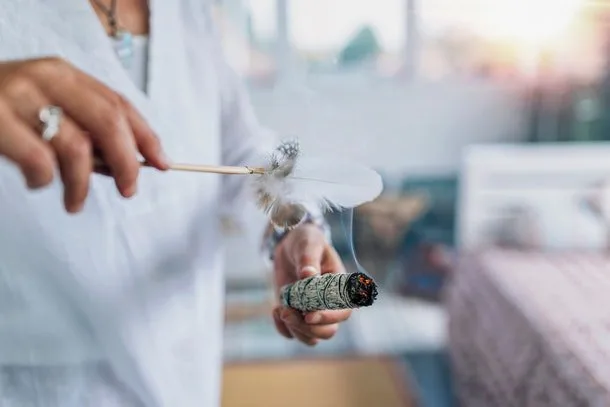2020 may be behind us, but that doesn’t mean that we still aren’t dealing with its impact. It’s been a stressful few months, and we’re all just trying to find our way through the chaos, all while managing our stress levels. Now, in an effort to address our rising stress levels, a lot of us have turned to alternative medicine, and as such, we’re finding interest in healing crystals, and we’re also following in the footsteps of many Native Americans by burning more sage.
Burning sage — also known as smudging — is an ancient spiritual practice established by Native Americans, most notably the Lakota, Chumash, Cahuilla. With many people often using the phrase go burn some sage in regards to cleaning up your energy, the practice has become increasingly mainstream. However, with questions about whether the practice benefits the body, as well as concerns about ethics and cultural appropriation, is it worth lighting up?
Clary sage is a popular essential oil that is said to have many benefits. Some clary sage benefits include helping to improve mental clarity and focus, boosting energy levels, and improving circulation. Its smell is sweet, refreshing, and safe for children, pets, and the environment. This natural essential oil works on dirt, mildew, and mold. Read on for some sage advice.
So, what is sage?
Simply put, sage is a plant. It’s regularly featured in the medicinal and food world. In regards to its medicinal role, various cultures around the world have been drawn to sage thanks to its antibacterial, antioxidant, and anti-inflammatory qualities.

Photo by Karolina Grabowska from Pexels
Smudging is the English term to describe the process whereby dried sage, along with other natural elements, is burned, and the omitted smoke is used to cleanse people, objects, or even places.
What are the benefits of sage?
1. It purifies
Thanks to its antimicrobial properties, sage can help to purify the air by keeping away bacteria, viruses, and fungi.
According to a study published in the Journal of Ethnopharmacology, smudging was found to kill 94% of airborne bacteria.
Poor air quality can increase the risk of asthma, coughing, and other respiratory infections and conditions. So by burning some sage, you can help yourself breathe better.
2. It dispels negative energy
Negative energy can actually have a detrimental effect on your health. Negative energy can trigger stress, and it can also affect how you see the world. A 2020 study from the University College London found that receptive negative thoughts can increase the risk of dementia (1).
If you’re worried about how negativity can take a toll on your health, turning to smudging can help to rid yourself — or your space — of negativity.
3. It’ll improve your mood
If you’re feeling a bit low, lighting some sage is a great way to improve your mood.
White sage is a common plant used for smudging. According to a study from the University of Mississippi, white sage contains certain compounds that activate specific receptors in the body. These receptors are responsible for mood, therefore the burning of white sage releases compounds that can help to boost mood levels, reduce stress, and even alleviate pain.

Photo by Brittany Colette on Unsplash
If you’re not into sage to lift your mood, you can try these six tips that will help you maintain spiritual health every day.
4. It’ll help you sleep better
Trouble sleeping? Well, that’s no surprise since the pandemic caused an array of sleep issues. Nonetheless, if you’re still struggling to get some quality shut-eye, then you could try smudging.
According to a study published in Der Pharmacia Lettre, sage contains certain compounds that can help ease insomnia. Coupled with its ability to reduce stress and clear the room of negative energy, lighting some sage at night may be exactly what you need to do to sleep better.
5. It’ll improve your cognition
Instead of doing a puzzle, if you really want to boost your brainpower, simply burn some sage!
While more research is definitely needed. a 2017 review of studies did find that sage’s cognitive-enhancing benefits are promising. Additionally, a separate study also found that the “aromas of the essential oils of Salvia species” can affect both cognition and mood.
Buying sage ethically
Unfortunately, in the 21st century, once something becomes commercialized, especially sacred cultural practices, the issues of ethics will always come into place.
There was a time when indigenous people underwent serious persecution for burning sage (prosecutors accused them of witchcraft). Plus, with white sage at risk of being endangered (it’s often illegally harvested), it’s important to ensure that you practice smudging ethically.
If you want to use sage ethically, then make sure to buy high-quality and ethically, legally sourced sage. To do this, you’ll probably avoid big retailers and rather opt for local and Native American-owned businesses.

Photo by Mikhail Nilov from Pexels
Respecting the practice
Again, Native Americans underwent serious prosecution for this practice so if you’re going to adopt it, then it’s important that you respect and engage in the practice without co-opting it thoughtlessly.
Bianca Millar is of the Wendake reserve in Québec (she’s half Huron-Wendat and half Scottish) and she runs an Indigenous beauty blog. Speaking to Fashionista, Millar says that non-Natives can sage, as long as they do so purposefully and mindfully. To do so, they suggest the following:
Don’t buy it
Instead of buying it, you can grow sage in your home.
“You need to make sure you’re growing it for the right reasons,” Millar cautions. “Grow it for yourself and for your family and your friends to share with them — as long as you’re not selling it for your own profit.”
Educate yourself
“There are little things that you would never think of,” Miller says. “Like, we don’t believe you should light your smudge or your sage with a lighter. We believe that the butane in lighters kind of kills that medicine, so you should use matches.”
Show respect
Millar suggests using a feather to fan the flames and please refrain from drinking or smoking and smudging.
With any practice, it’s always important to honor and respect its cultural roots before deciding to start practicing it.
How can I start saging?
What you need

Photo by michal dziekonski on Unsplash
You’ll need these basic tools:
- A sage bundle (or smudge stick) – you can learn how to make your own smudge stick here
- A seashell or bowl of ceramic, clay, or glass to hold burning sage or capture ash
- Matches
- Feather or fan for fanning smoke
- Sage
Saging your home, self, or object
- Set your intention
- Open a window or door before you start burning the sage.
- Light the end of the sage bundle with a match. Let it burn for several seconds and then blow it out so that it keeps smoking. If it stops emitting smoke, try lighting it again.
- The tips of the leaves should smolder slowly, releasing thick smoke.
- Direct this smoke around your body and space with one hand while holding the bundle in the other.
- Allow the incense to linger on the areas of your body, object, or surroundings you’d like to focus on. Using a fan or feather can also help direct the smoke, though this is optional.
- Allow the ash to be collected in a ceramic bowl or shell.
- Don’t allow any space to fill with too much smoke. Avoid inhaling smoke directly.
- Once you’re done, press the burning tip firmly into your fireproof vessel, dirt, or sand until the smoke no longer rises.
- Don’t get it wet! Getting it wet will ruin the tip of the stick and make it harder to light next time.
Are there any side effects or risks?
People with respiratory conditions such as asthma may be more sensitive to smoke, but aside from this, burning sage is generally safe to do. Just try to avoid breathing in the smoke and only burn sage for only short periods of time. 
Can I consume sage?
If you’re not looking to burn it. There are a few ways you can add sage to your diet. These include;
- Sage tea
- Add to soups
- Mix into stuffing
- Include in an omelet
References
Hayes, T. (2016). Terpenes and Flavonoids From Salvia apiana and Their Affinities to Cannabinoid and Opioid Receptors. Honors Theses. 899. https://egrove.olemiss.edu/hon_thesis/899
Lopresti A. L. (2017). Salvia (Sage): A Review of its Potential Cognitive-Enhancing and Protective Effects. Drugs in R&D, 17(1), 53–64. https://doi.org/10.1007/s40268-016-0157-5
Moss, L., Rouse, M., Wesnes, K. A., & Moss, M. (2010). Differential effects of the aromas of Salvia species on memory and mood. Human psychopharmacology, 25(5), 388–396. https://doi.org/10.1002/hup.1129
Nautiyal, C. S., Chauhan, P. S., & Nene, Y. L. (2007). Medicinal smoke reduces airborne bacteria. Journal of ethnopharmacology, 114(3), 446–451. https://doi.org/10.1016/j.jep.2007.08.038



![women [longevity live]](https://longevitylive.com/wp-content/uploads/2020/01/photo-of-women-walking-down-the-street-1116984-100x100.jpg)











I’m the Taté Walker referenced completely out of context in this article. I do not support what is written here, especially as it relates to the use of my name and cherrypicked comments. This is a trash article that only further harms Indigenous people and our spiritual practices – way to go, Longevity. Cultural genocide: Know it. Own it. Live it. A much smaller error in the grand scheme of things: The author references me as a “woman,” which is incorrect. Read here for better info and context https://www.thezoereport.com/p/the-significance-of-sage-among-native-american-nations-for-healing-health-45450613
Dear Taté Walker,
Thank you for writing to us with your concerns. Firstly we apologise for misgendering you. This was an honest error and the reference has been corrected. On the issue of your quote, we beg to differ with you on this as the quote is direct from a published source: “Walker and Miller agreed that sageing and smudging are not out of the question for non-natives if practiced purposefully and mindfully.” There was genuinely no intent by Longevity to disrespect any indigenous practices. We are a health and wellness website and our focus was the ethical use of sage for wellness purposes only. We are willing to remove your comments entirely from this article, or for you to give us a comment you would prefer us to use in the context of the specific paragraph as it relates to the health benefits of sage.” Please advise.